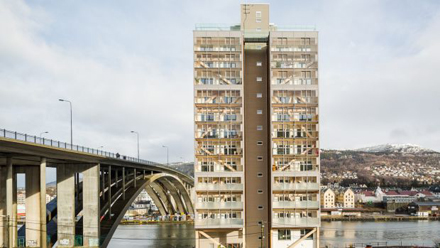
The Green Building Council of Australia has introduced a new criteria for low and zero-carbon buildings in the latest changes to its Green Star rating. Source: Architecture Au
Five- and six-star Green Star-rated buildings will now have to meet minimum greenhouse gas emission standards, while measures to increase industry capacity in air-tightness testing and to encourage the use of sustainably sourced structural timber have also been introduced.
A project with a five-star Green Star certification is now required to achieve three Green Star points in the “Greenhouse Gas Emissions” credit, and be 25% more efficient than a benchmark building.
A six-star Green Star building must achieve a minimum of six points and demonstrate efficiency of almost 40% above the benchmark.
“Our analysis has found that 95% of Green Star-certified projects meet these criteria, so it’s not a big change at the moment,” said the GBCA’s head of market transformation Jorge Chapa.
“However, it sends a signal to the market that we are prioritizing [low] carbon.”
The GBCA’ new chair Rod Fehring, who was appointed on 5 July announced that the council’s focus over the next year would be leading the shift to net zero buildings.
“As our cities grow, we have an obligation and an opportunity to embrace building practices that deliver healthy, resilient and positive places for people and the natural environment,” Fehring said.
“The GBCA’s board is determined to accelerate market transformation and to set the sustainability agenda throughout our region.”
Buildings seeking Green Start ratings will also now have to undergo an “air permeability performance” test to gain a “commissioning and tuning” credit, in a move that Chapa says is about building industry capacity and educating project teams about the value of air-tightness testing.
Sustainably sourced timber is increasingly being seen as an attractive construction material, with the Tasmanian state government introducing a timber-first policy, and several large-scale timber towers being built around Australia.
The Green Building Council has recognized the importance of timber to a sustainable future, introducing a new prescriptive pathway for the use of structural timber that aims to incentivize the material’s use.
While the Green Star rating system previously recognized the use of sustainably sourced timber project teams needed to undertake a full lifecycle analysis to achieve Green Star points.
“This change makes it easier for project teams to gain points using responsibly sourced timber, just the way we encourage the use of sustainable concrete and steel,” said Chapa.
The changes made by the council also include ways to enhance the workplace of construction workers.
The “Construction Environmental Management” credit has been renamed “Responsible Construction Practices,” with a new point available for project teams that can demonstrate high-quality staff support through health and wellbeing programs.
The Green Star rating system was launched in 2003 as a voluntary rating system that assesses the sustainability of projects at all stages of the built environment lifecycle.
According to the council almost 1500 projects have been Green Star certified around Australia and 38 percent of the nation’s office space is Green Star certified.
The Green Building Council’s head of market transformation Jorge Chapa said the changes to the internationally recognized rating system would help drive innovation in sustainable design and construction.





